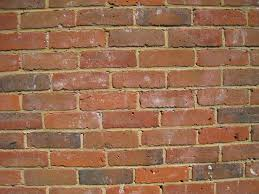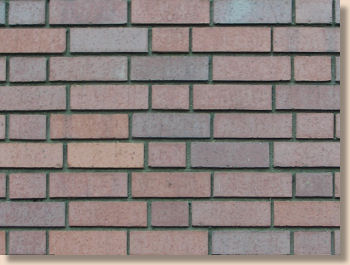Types of brick bonding
Contents |
[edit] What is brick bonding?
Brick bonding is the pattern in which bricks are arranged in a structure such as a wall or column.
Very broadly, bricks can be laid as soldiers (standing upright), stretchers (laid lengthwise along the wall) or headers (laid width wise along the wall).
Bricks are typically laid to an offset pattern to maintain an adequate lap between joints from one course to the next and to ensure that vertical joints are not positioned above one another on consecutive courses.
[edit] What is the objective of brick bonding patterns?
- Distribute loads throughout the structure to achieve maximum strength.
- Ensure stability.
- Achieve the desired aesthetic.
There are a great number of brick bonding patterns available. Factors affecting the selection of a brick bonding pattern include; the strength that is required, the thickness of the structure, the part of the structure (for example, a course of bricks over a window might have a different bonding pattern) the aesthetic requirement, the type and size of brick being used, local tradition and so on.
[edit] Types of brick bonding patterns
A number of commonly used brick bonding patterns are described below.
[edit] Stretcher bond
Stretcher bond is the most commonly used brick bond pattern in the UK. It is formed using only stretchers (bricks laid lengthwise), with the joins on each course centred above and below by half a brick. This type of bonding is not particularly strong.
A variation is the raking stretcher bond. The overlap between bricks is usually a third or a quarter of a brick, instead of half a brick.
[edit] English bond
English bond is a pattern formed by laying alternate courses of stretchers and headers. The joins between the stretchers are centred on the headers in the course below. This is one of the strongest bonds but requires more facing bricks than other bonds.
[edit] English garden wall
English garden wall bond is similar to the English bond but with one course of headers for every three courses of stretcher. The headers are centred on the headers in course below. This gives quick lateral spread of load and uses fewer facings than an English bond.
[edit] English cross bond
English cross bond alternates courses of stretchers and headers, with the alternating stretcher course being offset by half a brick. The stretchers are centred on the joins between the stretchers below them, so that the alternating stretcher courses are aligned. Staggering stretchers enables patterns to be picked out in different texture or coloured bricks.
[edit] Flemish bond
The Flemish bond is formed by laying headers and stretchers alternately in each course. The headers of each course are centred on the stretchers of the course below. This bond is strong and often used for walls which are two-bricks thick.
[edit] Flemish garden wall (also called Sussex bond)
The Flemish garden wall bond (or Sussex bond) is a variant of the Flemish bond, and uses one header to three stretchers in each course. The header is centred over the stretcher in the middle of a group of three in the course below.
[edit] Monk bond
The monk bond is a variant of the Flemish bond and involves two stretchers between the headers in each course. The headers are centred over the join between the two stretchers in the course below.
[edit] Header bond
The header bond features courses of headers offset by half a brick. It is similar to the stretcher bond but with headers instead of stretchers.
[edit] Stack bond
In stack bond, bricks are laid directly on top of one another with joins aligned, running vertically down the entire wall. Bricks can either be stacked horizontally or vertically.
The alignment of joints results in minimal bonding which means that this bond is weak and often structurally unsound unless wire bed-joint reinforcement is placed in every horizontal course or, where loading is moderate, every alternate course. This is often used purely for decorative purposes and in rain-screen applications.
[edit] Sussex bond
The Sussex bond is the same as the Flemish garden wall bond, and uses three stretchers and one header in each course.
[edit] Running bond
The 2018 International Residential Code (IRC), published by the International Code Council (ICC) defines running bond as: ‘The placement of masonry units such that head joints in successive courses are horizontally offset not less than one-quarter the unit length.’
Others might include facing bond, Dutch bond, raking bond, zigzag bond, diagonal bond, herringbone and herring bonds, monk bond, rat trap bond to mention a few.
[edit] Related articles on Designing Buildings
Featured articles and news
Homes England creates largest housing-led site in the North
Successful, 34 hectare land acquisition with the residential allocation now completed.
Scottish apprenticeship training proposals
General support although better accountability and transparency is sought.
The history of building regulations
A story of belated action in response to crisis.
Moisture, fire safety and emerging trends in living walls
How wet is your wall?
Current policy explained and newly published consultation by the UK and Welsh Governments.
British architecture 1919–39. Book review.
Conservation of listed prefabs in Moseley.
Energy industry calls for urgent reform.
Heritage staff wellbeing at work survey.
A five minute introduction.
50th Golden anniversary ECA Edmundson apprentice award
Showcasing the very best electrotechnical and engineering services for half a century.
Welsh government consults on HRBs and reg changes
Seeking feedback on a new regulatory regime and a broad range of issues.
CIOB Client Guide (2nd edition) March 2025
Free download covering statutory dutyholder roles under the Building Safety Act and much more.
Minister quizzed, as responsibility transfers to MHCLG and BSR publishes new building control guidance.
UK environmental regulations reform 2025
Amid wider new approaches to ensure regulators and regulation support growth.
BSRIA Statutory Compliance Inspection Checklist
BG80/2025 now significantly updated to include requirements related to important changes in legislation.


































Comments
[edit] To make a comment about this article, click 'Add a comment' above. Separate your comments from any existing comments by inserting a horizontal line.